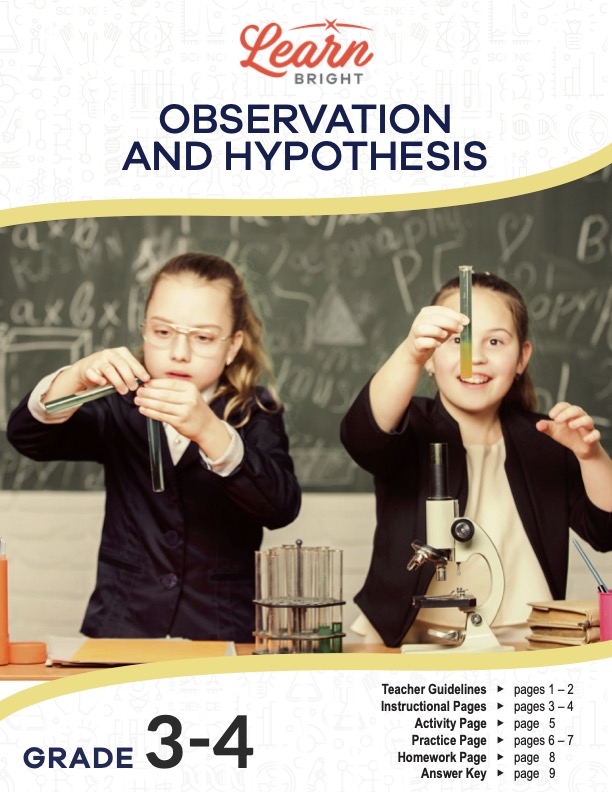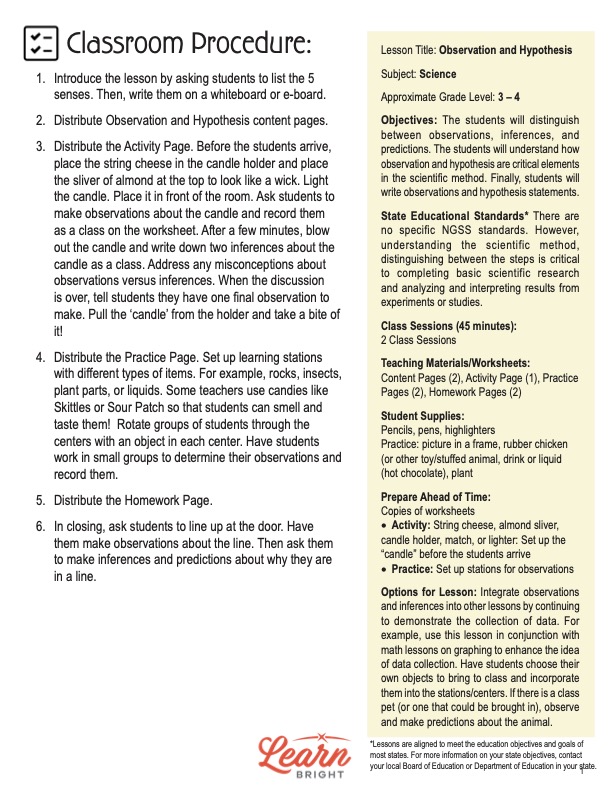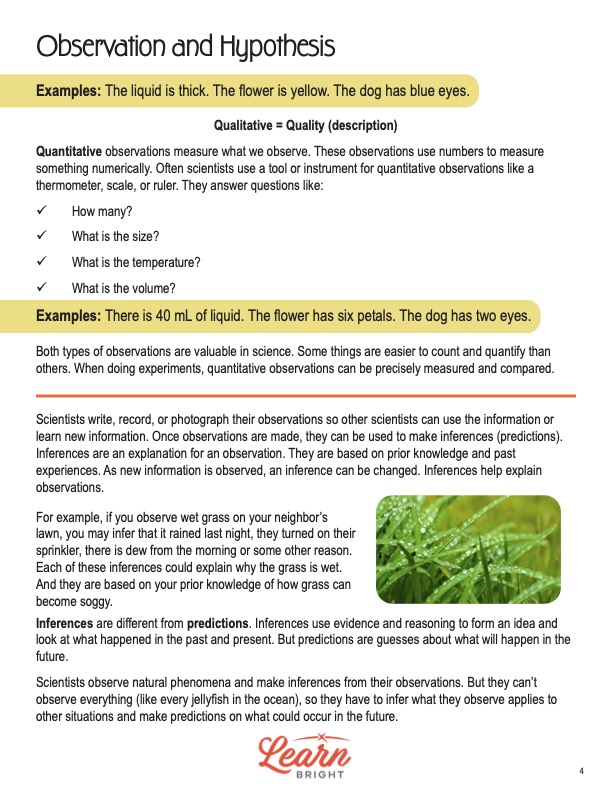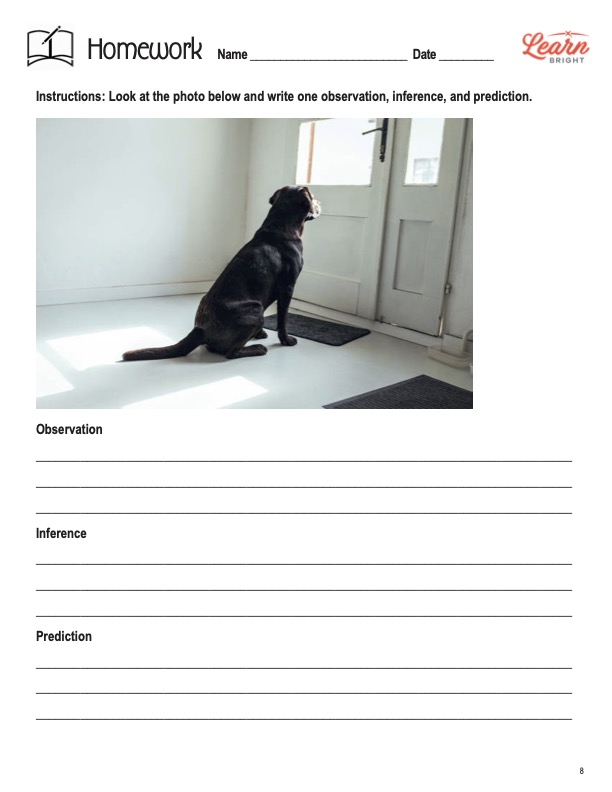Description
What our Observation and Hypothesis lesson plan includes
Lesson Objectives and Overview: Observation and Hypothesis teaches students about two important steps of the scientific method. Students will discover the difference between an observation, a hypothesis, and an inference. They will also learn why these steps are so critical to the scientific method and how to develop their own observations and hypotheses. This lesson is for students in 3rd grade and 4th grade.
Classroom Procedure
Every lesson plan provides you with a classroom procedure page that outlines a step-by-step guide to follow. You do not have to follow the guide exactly. The guide helps you organize the lesson and details when to hand out worksheets. It also lists information in the yellow box that you might find useful. You will find the lesson objectives, state standards, and number of class sessions the lesson should take to complete in this area. In addition, it describes the supplies you will need and what and how you need to prepare beforehand. For the activity of this lesson, you will need string cheese, almond slivers, candle holders, and matches or lighters. The practice station requires some prep work, so review the classroom procedure page guidelines and information in the “Student Supplies” for more information.
Options for Lesson
In the “Options for Lesson” section of the classroom procedure page, you will see some suggestions for additional activities or ideas to add to the lesson if you want to. You could integrate observations and inferences into other lessons by continuing to demonstrate the collection of data. For example, you can use this lesson in conjunction with math lessons on graphing to enhance the idea of data collection. Another option is to have students choose their own objects to bring to class and incorporate them into the stations for the practice worksheet. If there is a class pet (or one that could be brought in), you can observe and make predictions about the animal as a class.
Teacher Notes
The paragraph on this page provides a little more information or guidance on what to expect from the lesson. It explains that students will have the opportunity to learn about both qualitative and quantitative data. You can use the blank lines to record any thoughts or ideas you have as you prepare.
OBSERVATION AND HYPOTHESIS LESSON PLAN CONTENT PAGES
Using Our Senses
The Observation and Hypothesis lesson plan includes two pages of content. The first thing students learn is that an observation involves gathering information using the five senses. It is, basically, something we notice about the world around us. The five senses are touch, hearing, smell, taste, and sight.
On this page, the lesson outlines each sense, the organ that generates or allows the sense, and the parts involved. For sight, the organ is the eyes, and the parts involved include the cornea, pupil, iris, lens, retina, and optic nerve. The sense of smell happens with the nose, involving the nostrils, nasal cavity, and olfactory nerve.
The tongue allows for the sense of taste using taste buds and nerves. Our sense of touch happens with the largest organ of the human body—the skin. The nerve endings in our skin allow us to use this sense. And finally, the sense of hearing happens with the ears using the ear canal, ear drum, and three small bones.
Qualitative vs. Quantitative
Scientists constantly make observations, and there are two types: qualitative and quantitative. Qualitative data is the kind that describes what we observe. It is sensory in nature, and we can use adjectives to describe this data. To gather such information, we can ask questions about how something feels, what it smells like, what color it is, and so on.
On the other hand, quantitative data is the kind that measures what we observe. These observations use numbers to measure things numerically. Scientists often use a tool or instrument for these kinds of observations, like a thermometer, scale, or ruler. To find this kind of information, we can ask questions about how many of something there are, what the size of something is, what the temperature is, and so on.
Both types of observations are valuable in science. Scientists record or photograph their observations so that others can use the information or learn new information. In fact, once someone makes an observation, people can then use it to make inferences about something. An inference is an explanation for an observation. We base inferences on prior knowledge and past experiences.
For example, if we observe wet grass on our neighbor’s lawn, we can infer that it rained the night before, they turned on the sprinkler, or some other reason. Each inference can explain why the grass is wet. And we would make such inferences based on our prior knowledge of how grass can become soggy.
Inferences are not the same thing as predictions. Inferences use evidence and reasoning to form an idea and look at what happened in the past and is happening in the present. Predictions, however, are guesses about what will happen in the future. Scientists observe natural phenomena and infer based on those observations. They also make predictions about what could happen in the future.
OBSERVATION AND HYPOTHESIS LESSON PLAN WORKSHEETS
The Observation and Hypothesis lesson plan includes three worksheets: an activity worksheet, a practice worksheet, and a homework assignment. Each one will help students solidify their grasp of the material they learned throughout the lesson. You can refer to the classroom procedure guidelines to know when to hand out each worksheet.
CANDLE EXPERIMENT ACTIVITY WORKSHEET
As the teacher, you will be the one demonstrating for the students while they fill out the activity worksheet. Your instructions are in the guidelines on the classroom procedure page. As you perform the simple experiment of the candle and flame, students will record what they observe in the chart on the activity page. There are two columns, one for qualitative observations and one for quantitative. At the bottom are yellow boxes where students can write their inferences about the candle.
QUALITATIVE AND QUANTITATIVE PRACTICE WORKSHEET
For the practice worksheet, students will look at four different objects. Using the four tables on the page, they will write qualitative observations in one column and quantitative in the other. They should record at least three or four things they observe about each object.
OBSERVATION AND HYPOTHESIS HOMEWORK ASSIGNMENT
The homework assignment requires students to look at a picture of a dog waiting near the front door of a house. After looking at the photo, students will write one observation, one inference, and one prediction related to the picture.
Worksheet Answer Keys
The last page of the lesson plan document is an answer key for the homework worksheet. The answers are in red to make it easy for your to compare them to students’ work. Given the nature of the assignment, the answers are sample responses of what students might write. If you choose to administer the lesson pages to your students via PDF, you will need to save a new file that omits this page. Otherwise, you can simply print out the applicable pages and keep this one as reference for yourself when grading assignments.









